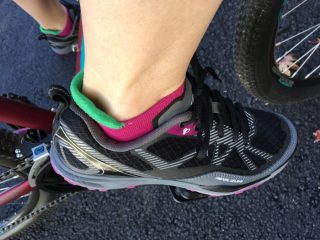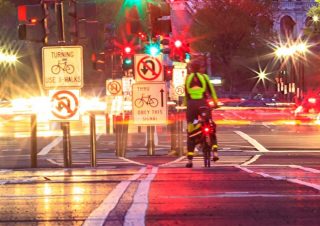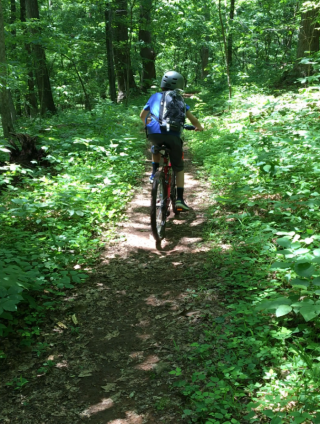The family cycle
Biking road rules for safe family riding
Whether for recreation or a mode of transportation, bicycling is an excellent way to get exercise and get where you want to go. Cycle safely by following riding rules for the trail, the street or anywhere your two-wheeler takes you.
Be a helmet head
A helmet is a no-brainer, and it’s the cheapest form of head-injury insurance you can get, yet many riders forgo a helmet thinking unless they are performing extreme BMX tricks that they don’t need it. No matter if you are on a short ride around the block or a rocky single-track, cover your head.

Check it out
Check your equipment before every ride. Make sure tires are inflated properly, and test out your brakes, handlebar, and shifting to make sure it’s in good working order before you ride. Make sure your bicycle is in good mechanical condition with a regular checkup and tune-up by a certified mechanic.
Best buddies
Always bring your phone and ID, and ride with a buddy. If you break down or are injured, your riding companion could be a lifesaver. Coordinate with your partner before you set off as to your riding plan, and make sure your companion knows what hand signals you will use for turning, slowing and stopping. Also, tell others when you are going for a ride, where you plan on going, and when you plan to return.
Hydrate your ride
Bring along plenty of water. Most bicycles have cages to keep a water bottle or predrilled outlets to mount them. If you don’t want the extra weight or the obstacle of a water ball bottle mounted on the bike itself, or if you want to be competitive and streamline your ride without water breaks, Camelback and many other brands make backpack style hydration systems so you can sip while you ride.

Get lit
When driving at dusk or dawn or in traffic, use a bike light. The safest lighting systems are those that are always on, like car running lights, with front- and rear-facing daytime lights which have been proven to decrease the likelihood of a collision up to 33%.
Bontrager Flare R bike light is one of the best for daylight visibility, as demonstrated in this video:
https://www.youtube.com/watch?v=5nC8zf_9FOc
Dress up
Wear contrasting clothing and gear. Accessorizing in tennis-ball-bright fluorescent and reflective gear and apparel has been shown to decrease a rider’s risk of incident by as much as 53% during the day and makes you 72% more noticeable at night.

Proper biking attire is not just for fashion. Wear appropriate clothing for cycling that is snug to the body to prevent it catching on saddles, handlebars or other bike parts. Fear not, you do not have to look like leg-warmer-wearing extra from Glow. Many cycling apparel brands make functional but decent looking hoodies, sweatshirts, jerseys and other performance wear that you might even wear out after your ride. Never tie clothing around your waist, wrap clothing around handlebars, or otherwise attach items to yourself or your bike where they can come lose and catch in moving parts.

If you are riding with clipless pedals, make sure your shoes are properly fitting and cleats and clips are free of mud and are in good working condition. Practice snapping in and snapping out of them before each ride to make sure you are able to clip out in a hurry if needed.

Map it
Know where you are headed. There are many mobile GPS tools like Avenzamaps can help you map and mark your way so that you don’t get lost on the road, woods or mountains. Make sure you are riding for your skill level. Rails to Trails Conservancy has ratings and reviews on many trails to guide you in choosing your riding terrain.
Road rules
Stay on designated trails. Wherever there is a marked bike route, use it. But be aware of vehicles around you at all times, even if you are in a bike lane, as motorists don’t always yield right of way. Obey traffic signs and follow the rules of the road the same as if you would behind the wheel. Ride in the same direction as traffic, on the right side of the road. If there is no bike lane, ride on the shoulder, but ride slightly in the lane rather than the edge of the road, which will cause cars to cautiously pass you, and you will have room to maneuver or bailout if needed.

If you are at an intersection with a traffic light but your bicycle will not trigger the sensor for the light to change, the best option is use the crosswalk as a pedestrian.
Listen up
If you want to listen to music while you ride, wear wireless headphones that can’t get tangled on handlebars and use an earbud with an open design that allows ambient noise so that you can hear your surroundings.
Even if you’re on a biking path, you must still follow the rules of the road. Use an audible signal when you are passing, and only pass on the left. On single-track mountain biking trails, the uphill rider has the right of way. Ride single file and give hand signals when turning, slowing and stopping.
Follow your heart
Nobody wants to be so concerned about safety that bike riding loses its fun. If you have the correct gear, in working order, and you know where you are going and the rules of the road, you will be relaxed on your ride, so plan ahead, so that you can get rolling with ease.

